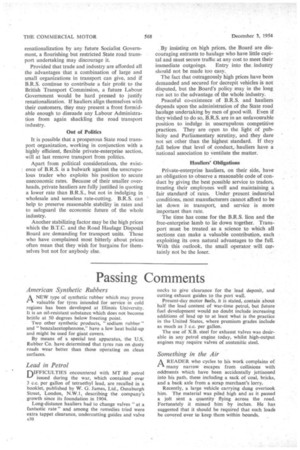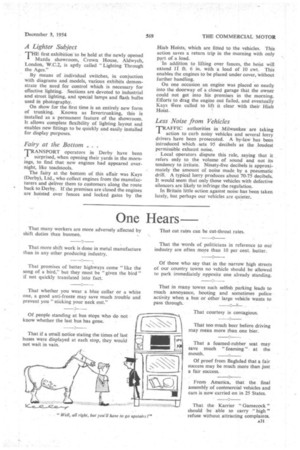Passing Comments
Page 32

Page 33

If you've noticed an error in this article please click here to report it so we can fix it.
American Synthetic Rubbers
A NEW type of synthetic rubber which may prove " valuable for tyres intended for service in cold regions has been developed at Illinois University. It is an oil-resistant substance which does not become brittle at 50 degrees below freezing point.
Two other synthetic products, " sodium rubber" and " benzalacetophenone," have a low heat build-up and might be used for giant covers. • By means of a special test apparatus, the U.S.
Rubber Co. have determined that tyres run on dusty roads wear better than those operating on clean surfaces.
Lead in Petrol
DIFFICULTIES encountered with MT 80 petrol issued during the war, which contained Over 3 c.c. per gallon of tetraethyl lead, are recalled in a booklet, published by W. G. James, Ltd., Osnaburgh Street, London, N.W.1, describing the company's growth since its foundation in 1904.
Long-distance hauliers had to change valves "at a fantastic rate" and among the remedies tried were extra tappet clearance, undercutting guides and valve A30 necks to give clearance for the lead deposit, and cutting exhaust guides to the port wall.
Present-day motor fuels, it is stated, contain about half the lead content of war-time petrol, but future fuel development would no doubt include increasing additions of lead up to at least what is the practice in the United States, where premium grades include as much as 3 c.c. per gallon.
The use of X.B. steel for exhaust valves was desirable in any petrol engine today, whilst high-output engines may require valves of austenitic steel.
Something in the Air
AREADER who cycles to his work complains of many narrow escapes from collisions with oddments which have been accidentally jettisoned into his path, these including a sack of coal, bricks, and a back axle from a scrap merchant's lorry. Recently, a large vehicle carrying dung overtook him. The material was piled high and as it passed a jolt sent a quantity flying across the road. Fortunately it missed him by inches. He has suggested that it should be required that such loads be covered over to keep them within bounds. _ A Lighter Subject THE first exhibition to be held at the newly opened Mazda showroom, Crown House, Aldwych, London, W.C.2, is aptly called "Lighting Through the Ages."
By means of individual switches, in conjuction with diagrams and models, various exhibits demonstrate the need for control which is necessary for effective lighting. Sections are devoted to industrial and street lighting, and special lamps and flash bulbs used in photography.
On show for the first time is an entirely new form of trunking. Known as Invertrunking, this is installed as a permanent feature of the showroom. It allows complete flexibility of lighting layout and enables new fittings to be quickly and easily installed for display purposes.
Fairy at the Bottom . . .
TRANSPORT operators in Derby have been surprised, when opening their yards in the mornings, to find that new engines had appeared overnight, like toadstools.
The fairy at the bottom of this affair was Kays (Derby), Ltd., who collect engines from the manufacturers and deliver them to customers along the route back to Derby. If the premises are closed the engines are hoisted over fences and locked gates by the Hiab Hoists, which are fitted to the vehicles. This action saves a return trip in the morning with only part of a load.
In addition to lifting over fences, the hoist will extend 11 ft. 6 in. with a load of 10 cwt. This enables the engines to be placed under cover, without further handling.
On one occasion an engine was placed so neatly into the doorway of a closed garage that the owner could not get into his premises in the morning. Efforts to drag the engine out failed, and eventually Kays tfere called to lift it clear with their Hiab Hoist,
Less Noise from Vehicles
TRAFFIC authorities in Milwaukee are taking action to curb noisy vehicles and several lorry drivers have been prosecuted. A by-law has been introduced which sets 95 decibels as the loudest permissible exhaust noise.
Local operators dispute this rule, saying that it refers only to the volume of sound and not its tendency to irritate. Ninety-five decibels is approximately the amount of noise made by a pneumatic drill. A typical lorry produces about 70-75 decibels. It would seem that only those vehicles with defective silencers are likely to infringe the regulation.
In Britain little action against noise has been taken lately, but perhaps our vehicles are quieter.
















































































































